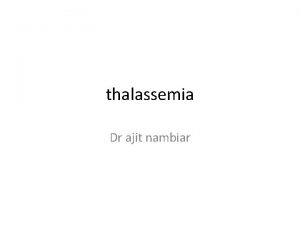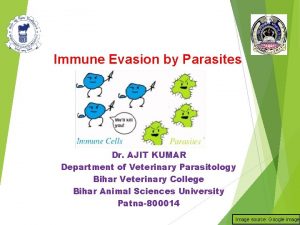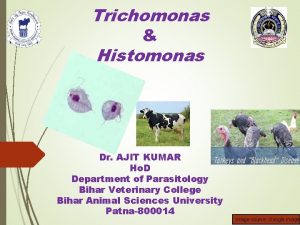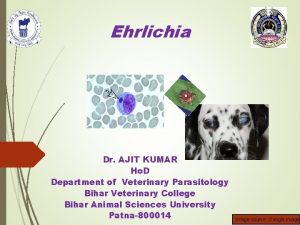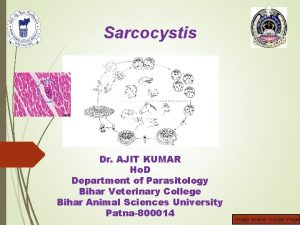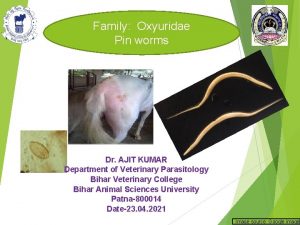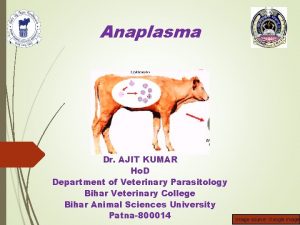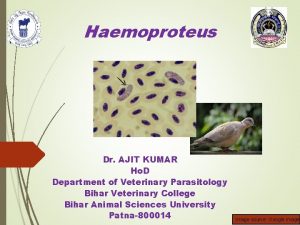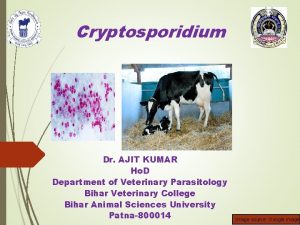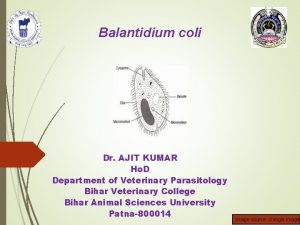Rickettsiales Dr AJIT KUMAR Ho D Department of

















- Slides: 17

Rickettsiales Dr. AJIT KUMAR Ho. D Department of Parasitology Bihar Veterinary College Bihar Animal Sciences University Patna-800014 Image source: Google image

Order : Rickettsiales Genus: Anaplasma ü Anaplasma species appear as small (0. 2 -0. 5 µm in diameter), round, dark red bodies with no cytoplasm and with a light halo may found around them inside the erythrocytes. ü One erythrocytes may than one organisms. occasionally have more

Genus: Anaplasma Species Definitive host Location Transmission/ Vector Anaplasma marginale Cattle usually near the margin of RBCs Anaplasma centrale -do- In the centre of RBCs Various species of ticks, flies, contaminated surgical instruments etc. -do- Anaplasma ovis Sheep and goat RBC -do-

Anaplasma marginale found on or near the margin of erythrocytes in stained blood films. Image source: Google image

Anaplasma marginale Transmission: • Transmitted through various species of ticks (transovarian transmission), biting flies and even mosquitoes (mechanical transmission) help in transmission of anaplasmosis. • Disease can also be transmitted mechanically by infected blood contaminating the hypodermic needle, use in mass vaccination and castration, ear tagging and dehorning instruments. Source of infection is always the blood of an infected animal.

Life- cycle of A. marginale Image source: Google image

Anaplasma marginale Disease : Anaplasmosis or gall sickness Pathogenesis & Symptoms: Anaplasmosis is a disease of adult cattle and clinical anaplasmosis is mostly seen in cattle above 18 months of age. Younger animals are susceptible to infection but clinical symptoms do not occur.

Anaplasma marginale Pathogenesis & Symptoms: Anaplasma organisms infected erythrocytes are engulfed (erythrophagocytosis) by the cells of reticuloendothelial system (Spleen and bone marrow) and cause extra vascular haemolysis leading to anaemia. Symptoms include fever, anorexia, anaemia, jaundice and may be abortion in pregnant cows.

Anaplasma marginale Treatment : Oxytetracycline @6 -10 mg/kg b. wt i/m is drug of choice in treatment of anaplasmosis. Amvac and Anaplaz Anaplasma marginale. vaccines have been prepared against

Order : Rickettsiales Genus: Ehrlichia It is small pleomorphic gram negative coccoid intracytoplasmic inclusion bodies found in circulating leucocytes. Organisms may occur singly or generally in compact colonies as morula in the cytoplasm of leucocytes. Image source: Google image

Order : Rickettsiales Genus: Ehrlichia Species Ehrlichia canis Definitive host Location Dog Monocyte Ehrlichia ewingi Dog Neutrophil Vector Rhipicephalus sanguineus (Brown dog tick) Ehrlichia chaffeensis Dog and human Monocyte

Order : Rickettsiales Genus: Ehrlichia Transmission: • It is transmitted transtadially by the tick and also through infected blood transfusion. Image source: Google image

Order : Rickettsiales Genus: Ehrlichia Pathogenesis & symptoms: Ehrlichia canis causes disease in dog known as canine rickettsiosis or tracker dog disease or canine typhus or canine haemorrhagic fever or tropical canine pancytopenia or emerging silent tick born disease of dog or AIDS of the canine world. Puppies may remain as carrier for a long time. Stress, immunological depression and concurrent with other infections may precipitate the disease. Symptoms includes undulating temperature, anaemia, polyarthritis, thrombocytopenia, corneal opacity, renal failure, clotting abnormalities leading to epistaxis, haematuria, haematemesis and haemorrhagic diarrhoea.

Genus: Ehrlichia Corneal opacity in E. canis infected dog Image source: Google image

Diagnosis : Order : Rickettsiales Genus: Ehrlichia Microscopic examination of stained blood smear revealed morula stage of Ehrlichia in leucocytes. Ehrlichia canis commonly found in mixed infection with Babesia canis or Hepatozoon canis. Persistence and duration of ehrlichiosis is usually unnoticed by the owner for long time due to variability in clinical signs. Image source: Google image Morula of E. canis in monocyte

Order : Rickettsiales Genus: Ehrlichia Treatment : - Doxycycline and Oxytetracycline are used in treatment of ehrlichiosis.

THANK YOU
 Professor ajit diwan
Professor ajit diwan Dr ajit nambiar
Dr ajit nambiar Ajit diwan iit bombay
Ajit diwan iit bombay Thalassemia inheritance
Thalassemia inheritance Rishabh ajit sambhav abhinandan
Rishabh ajit sambhav abhinandan Dr ajit saxena
Dr ajit saxena Ajit diwan
Ajit diwan Dr ajit singh
Dr ajit singh Veterinary council of pakistan
Veterinary council of pakistan Ajit gaddam
Ajit gaddam Pavan kumar vijay
Pavan kumar vijay Chapter 9 kumar steinbach tan
Chapter 9 kumar steinbach tan Prof. dr. pradeep kumar gupta
Prof. dr. pradeep kumar gupta Col 106 amit kumar
Col 106 amit kumar Akshay kumar
Akshay kumar Management assertions
Management assertions Subrata kumar panda
Subrata kumar panda Ravi kumar sacramento
Ravi kumar sacramento



